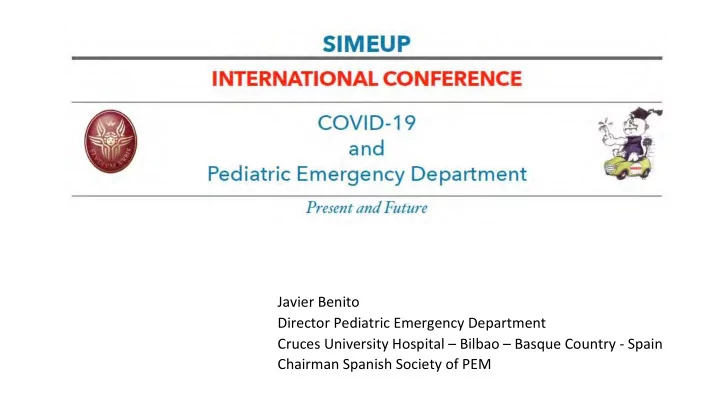

Javier Benito Director Pediatric Emergency Department Cruces University Hospital – Bilbao – Basque Country - Spain Chairman Spanish Society of PEM
Current numbers of Spain Cases in Spain Confirmed cases Deaths Recovered
COVID-19 Cases by age
COVID-19 Cases by age and clinical situaJon
PED episodes/week during COVID-19 pandemic PED - CUH 1400 1200 School Closure 1000 Lockdown 800 600 400 200 0 2ª Feb 3ª Feb 4ª Feb 1ª Mar 2ª Mar 3ª Mar 4ª Mar 5ª Mar 1ª Abr 2ª Abr 3ª Abr
Consequence • Transforming hospitals to COVID-19 • Diversion of human and material resources to care for adult paJents • ConcentraJon of Primary Care, ED and hospitalizaJon in few centers. • LimitaJon of face-to-face a\enJon Concern for delayed arrival to the emergency department in some paJents
How is your Pediatric Emergency Department organised ?
How is your Pediatric Emergency Department organised? • Two separate paJent flows, from triage to hospitalizaJon, COVID-19 and Non COVID-19. • One person per child and in COVID-19 flow both with surgical mask. • PPE instrucJons for professionals a\ending COVID-19 and Non-COVID-19 flow. • Professionals who care for unstable paJents, complete PPE. • Avoid aerosols (nebulizaJon and HFO). • Maintain usual criteria for hospitalizaJon. Individualized management of children with predisposing disease. • Perform SARS-CoV-2 PCR on paJents assigned to COVID-19 flow requiring hospitalizaJon. • Laboratory tests and X-rays according to clinical symptoms and severity.
Admisión: mascarilla quirúrgica al paciente y un familiar FLUJO PACIENTES. 1 Triaje UP en el lugar de siempre EPI La 3ª persona de triaje: URGENCIAS PEDIATRIA. enfermera limpia 1 AE HU CRUCES Paciente ¿Fiebre y/o Cuadro crídco respiratorio? Área de EPI Estabilización SI NO Triaje UP en el lugar de siempre No Trauma Trauma EPI Inestable Estable Nivel II Nivel IV 1 adjunto Triaje zona Sala de espera Sala de 1 Nivel III Nivel V 0/1 MIR interna UP, en Ambulatorio Curas enfermera 1 enfermera mostrador 4 1 adjunto Área de Ambulatorio 1 adjunto 1 MIR Reconocimient 1,2,3 externo 1 enfermera o 1/2 MIR Estancia máxima 18 horas Ciertos niveles III Nivel II Nivel IV-V Ciertos niveles III Alta Alta Área de Reconocimiento Planta* Planta* Consulta 1 adjunto Área de 1 MIR Fast- 1 Evolución track enfermera *Recogida de PCR en pacientes previo a ingreso si precisa • Radiología: Estancia máxima 24 horas • Zona ambulatoria: Rx 1 sucio • Reconocimiento: Rx sucio Alta Alta Área de Evolución Planta • Radiología: Planta • Reconocimiento: Rx 2 limpio SERVICIO DE URGENCIAS DE PEDIATRÍA. HU CRUCES. 26/03/2020
How is your Pediatric Emergency Department organised? • Two separate paJent flows: • COVID-19 Flow (Fever and/or respiratory symptoms). Surgical mask for the paJent and one parent/caregiver. • PPE: • Respiratory protecdon FFP2 respirator • Eye protecdon Goggles or face shield • Body protecdon Long-sleeved water-resistant gown • Hand protecdon Gloves • Non COVID-19 Flow • PPE: • Respiratory protecdon FFP2 respirator • Hand protecdon Gloves
How can you define a suspect case of coronavirus infecJon?
How do you manage the suspect paJent in the Emergency Department?
How do you manage the suspect paJent in the Emergency Department? • Tesdng (PCR): • PaJents with risk factors for poor evoluJon • PaJents with fever or respiratory symptoms who require hospital admission due to clinical criteria • Neonates with fever • Consider in paJents with radiological evidence of pneumonia, even if outpaJent management • Admission COVID-19 +: In general, the usual admission criteria are maintained • Neonates with fever • Hypoxemia (satO2 <92%) or moderate / severe respiratory distress that does not improve aier bronchodilator treatment • General poor condiJon, lethargy • Refuse feeding • Apnea • Consider admission in paJents with risk factors for poor evoluJon • Treatment in the ED : Avoid nebulizers and HFO
How do you manage the suspect paJent in the Emergency Department? • It is recommended that paJents who require admission have a blood test (hemogram, coagulaJon, venous blood gas, biochemistry with LDH, PCR and PCT) and a chest X-ray (ideally portable). • Consider the uJlity of chest ultrasound if available and trained personnel are available • Treatment in the SUP • SupporJve therapy • Avoiding nebulizaJon and HFO • Cephalosporin 3rd generaJon if suspect bacterial superinfecJon
coronavirus infected paJent? Which criteria do you use to define a • Clinical criteria • PCR SARS-CoV-2 posiJve
For paJents: healthy, suspect or infected do you have separate paths in pediatric emergency department? Admisión: mascarilla quirúrgica al paciente y un familiar FLUJO PACIENTES. 1 Triaje UP en el lugar de siempre EPI La 3ª persona de triaje: URGENCIAS PEDIATRIA. enfermera limpia 1 AE HU CRUCES Paciente ¿Fiebre y/o Cuadro crídco respiratorio? Área de EPI Estabilización SI NO Triaje UP en el lugar de siempre No Trauma Trauma EPI Inestable Estable Nivel II Nivel IV 1 adjunto Triaje zona Sala de Sala de espera 1 Nivel III Nivel V 0/1 MIR interna UP, Curas en Ambulatorio enfermera 1 enfermera mostrador 4 1 adjunto Área de Ambulatorio 1 adjunto 1 MIR Reconocimient 1,2,3 externo 1 enfermera o 1/2 MIR Estancia máxima 18 horas Ciertos niveles III Nivel II Nivel IV-V Ciertos niveles III Alta Alta Área de Reconocimiento Planta* Planta* Consulta 1 adjunto Área de 1 MIR Fast- 1 Evolución track enfermera *Recogida de PCR en pacientes previo a ingreso si precisa • Radiología: Estancia máxima 24 horas • Zona ambulatoria: Rx 1 sucio • Reconocimiento: Rx sucio Alta Alta Área de Evolución Planta • Radiología: Planta • Reconocimiento: Rx 2 limpio
In the pediatric emergency department do you have also a program of screenig for parents or caregiver? • InstrucJons for tesJng family members with symptoms in primary care
What are the clinical pictures that you have found in children with coronavirus infecHon? • Mild respiratory symptoms in paJents with risk factors for poor evoluJon • Pneumonia • BronchioliJs • Few severe cases
Martes, 29 de mayo de 2012
Recommend
More recommend